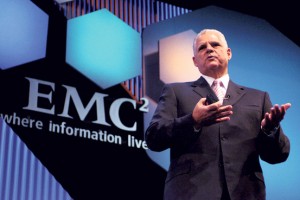VMware has announced that its vSphere cloud operating system will now come natively with EMC’s Avamar backup and recovery software, which also includes data deduplication capability.
Additionally, EMC announced its VFCache PCIe server flash cards now come native with inline data deduplication. The firmware is interoperable with VSphere vMotion to enable the migration of virtual machines (VMs) residing on flash memory.
VMware, which is owned by EMC, said the two companies developed vSphere 5.1 to simplify the setup and management of backups for VMs through a single VMware console.
The new capability, called vSphere Data Protection (VDP), replaces vSphere’s Data Recovery function and is included with all editions of vSphere Essentials+ and above.
“Smaller businesses and departments within larger organizations are the primary beneficiaries of this initial release, as well those who are at the outset of their virtualisation journey,” said David Vellante, co-founder of The Wikibon Project, a Web 2.0 community for IT professionals.
Like other backup software products, VMware and Avamar were already integrated at the API level, allowing users to purchase Avamar software and manage it through VMware’s vStorage API.
Now that VDP is integrated with vCenter, users can set up backup policies quickly and manage VDP directly from the vSphere Web Client. All VM data associated with the VDP virtual appliance is also automatically deduplicated at the block level.
VDP is suited for backing up a maximum of 100 VMs and can protect a storage pool of up to 2TB of deduplicated data, according to Steve Flynn, EMC director of product marketing for Avamar.
Another advantage of embedding the Avamar code directly into the vSphere software is that is can now perform change-block tracking, or the ability to backup only those blocks of data on VMs that have changed between backups. That reduces bandwidth requirements for backups.
Conversely, the change-block tracking allows VDP to restore only the data that has been changed since the last backup, which affords faster recovery time compared to restoring an entire VM.
“Part of the challenge you have in a VMware environment is there are so many VMs that if you try to crawl through everything to see what data has changed, you’ll never get things done in time,” said Shane Jackson, vice president of marketing for EMC’s Backup Recovery Systems Division. “You need VMware to be able to tell us, here are the three things that have changed since your last backup, so this is what you need to look for on your recovery.”
Through its VMware ownership, EMC also integrated its VFCache server flash cards with vSphere and announced deduplication on the cards.
The VFCache server cards, used alongside hard disk drives, form a tier of high-performance storage within a server that is accessible via the system’s fast PCIe bus. By deduplicating the data before it’s written to the flash on the cards, it delivers better cost-per-gigabyte of capacity and extends the life expectancy of the PCIe flash card, EMC said.
VFCache’s new interoperability with VMware vSphere vMotion enables data migration between servers using flash.
“Through the EMC VSI plug-in for VMware vCenter, EMC enables VMware administrators to handle other priority tasks and ensures business continuity with no system downtime when migrating operations,” EMC said in a statement.
In addition, administrators of EMC’s flagship VMAX storage array can drill down using VMware’s console to see information, such as VFCache’s relationships to specific logical unit numbers (LUNs), performance statistics and error condition reports.
Next year, EMC plans to integrate VFCache with the rest of the company’s array portfolio, including its midrange VNX line.
EMC also reiterated its support for Cisco’s upcoming offering of LSI’s customised PCIe Flash mezzanine cards for UCS B-series blade servers. EMC originally announced that support in May.
The latest version of VFCache supports multiple PCIe cards per server. Each PCIe card can hold up to 700GB of data.
Jeff Janukowicz, a research director at IDC, said the annual flash capacity shipped in the enterprise will grow by 20 times by 2016 because of the ever-growing number of applications, the digitisation of data, and the growing use of the cloud and Big Data.
“Storage I/O is a critical performance bottleneck for many data-intensive applications,” Janukowicz said. “Flash is the essential ingredient in the industry’s race for application speed. With these latest updates to EMC VFCache, EMC is delivering efficiency that didn’t previously exist for the customer. This addition to its comprehensive Flash portfolio is an important evolution.”






